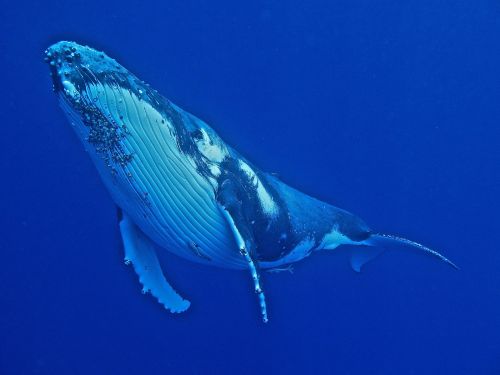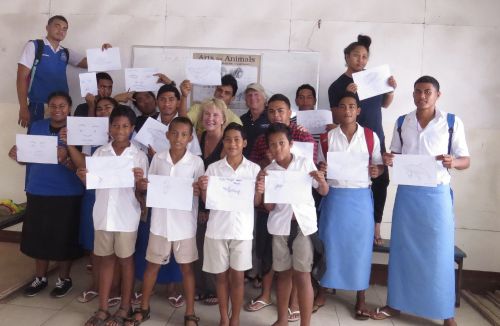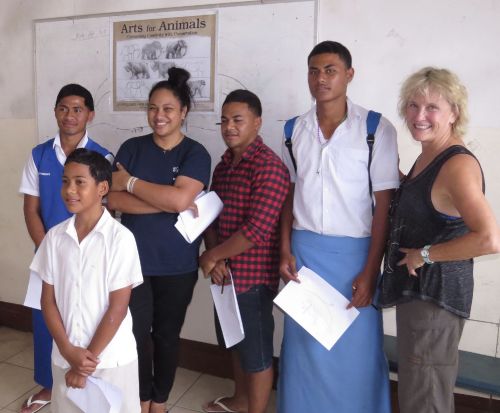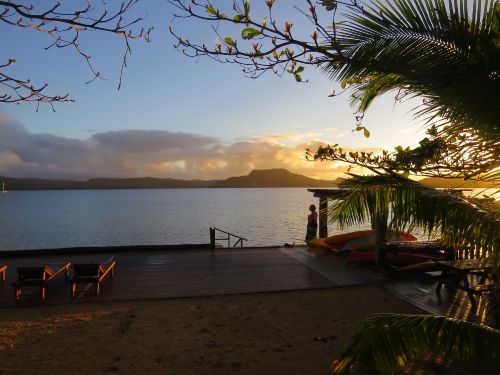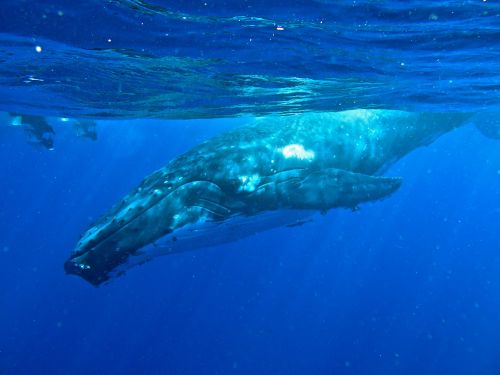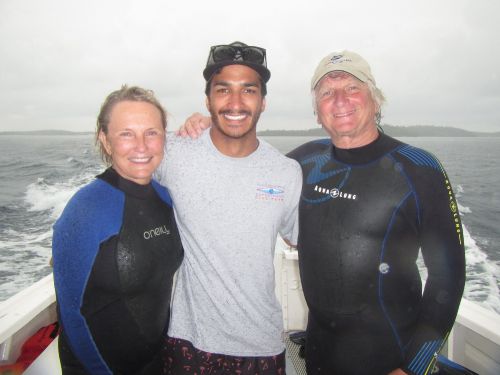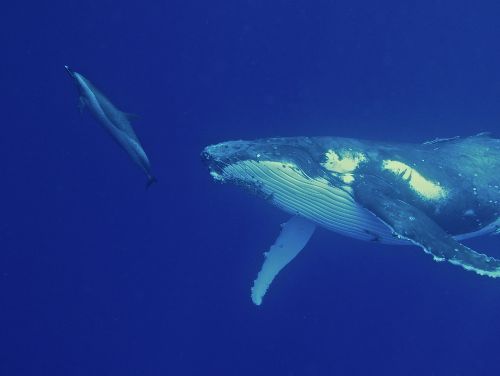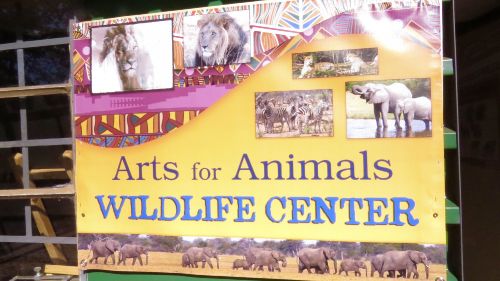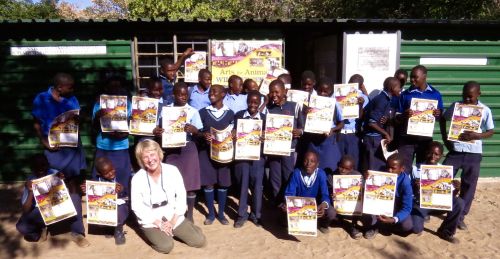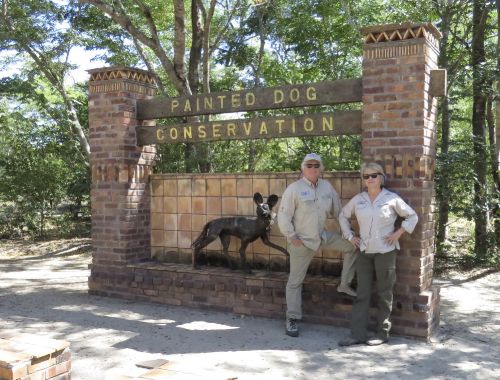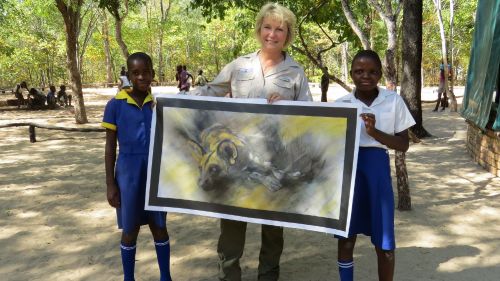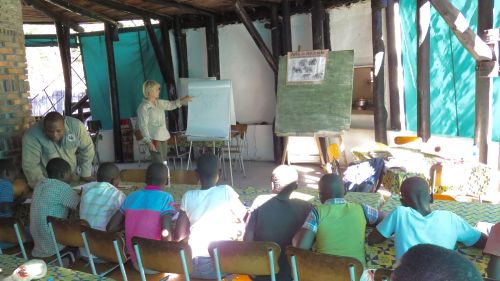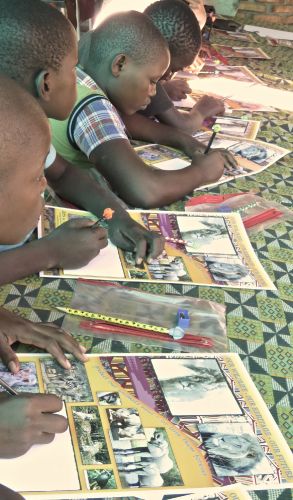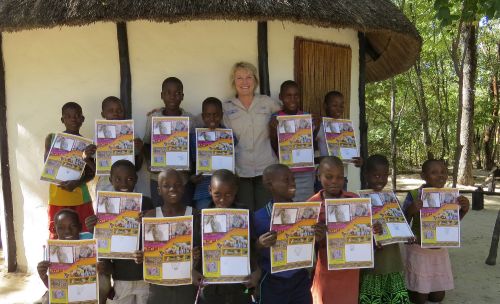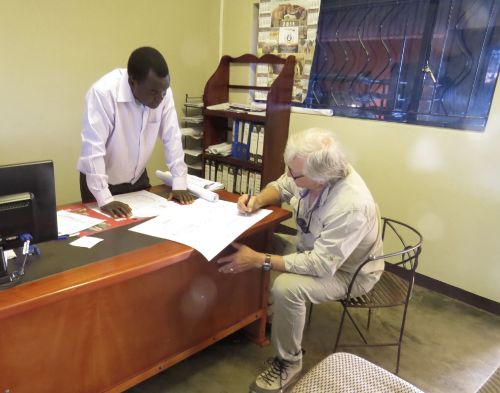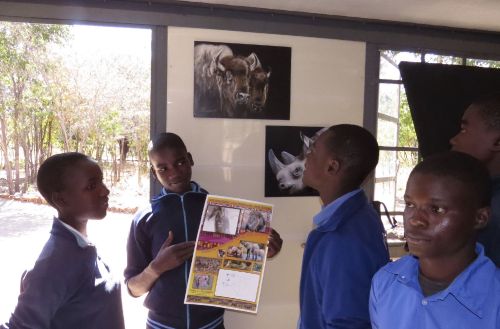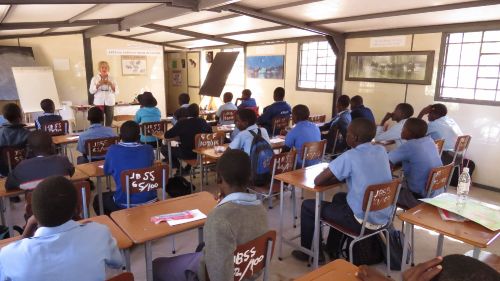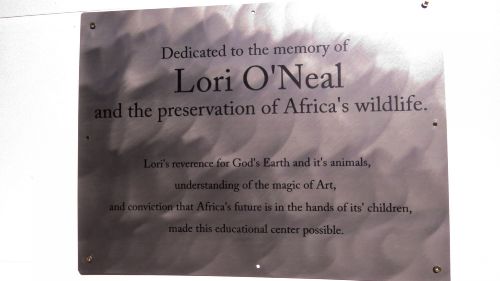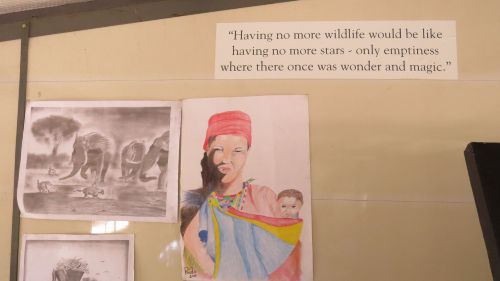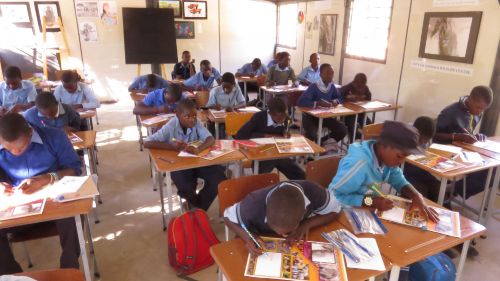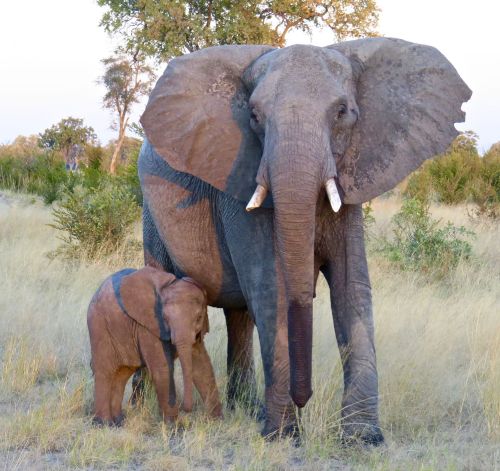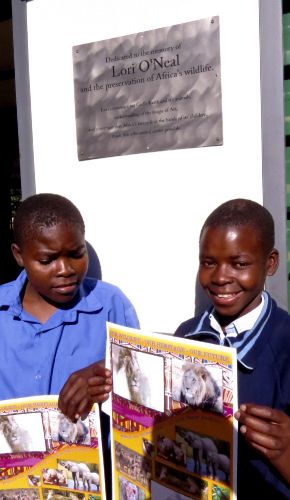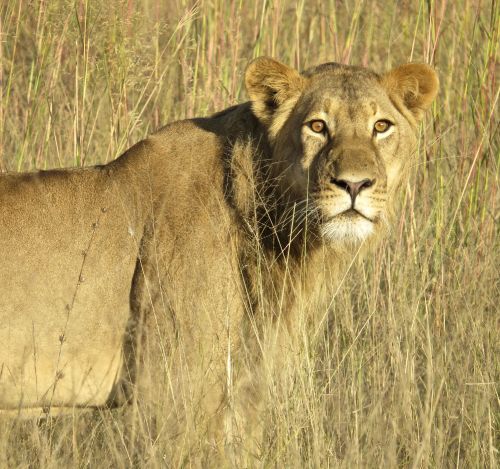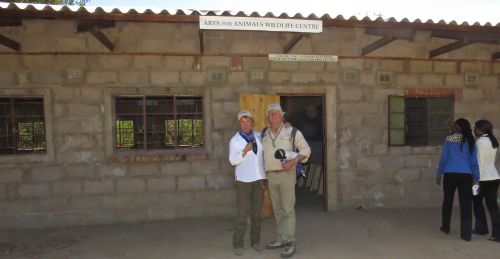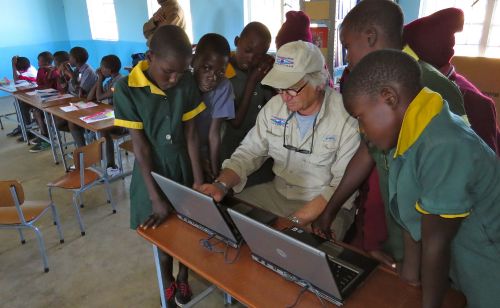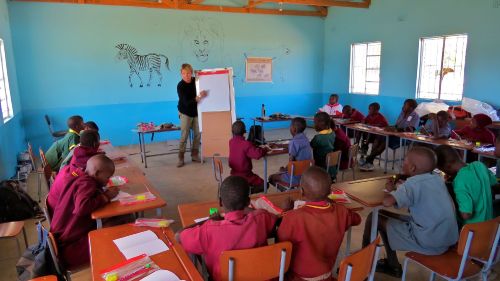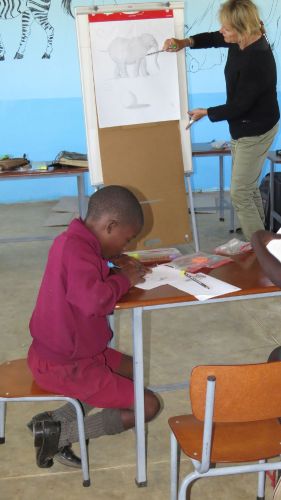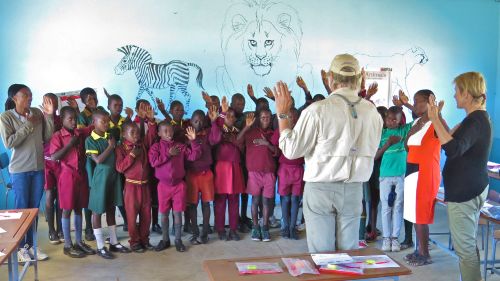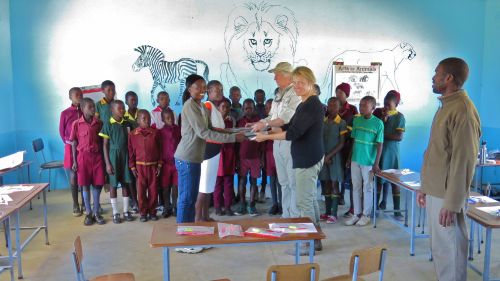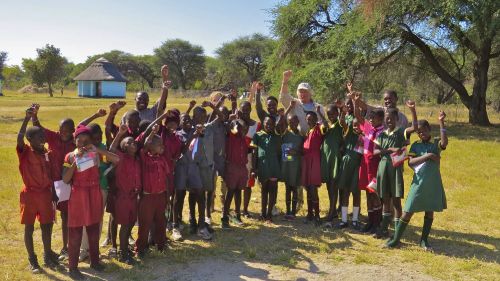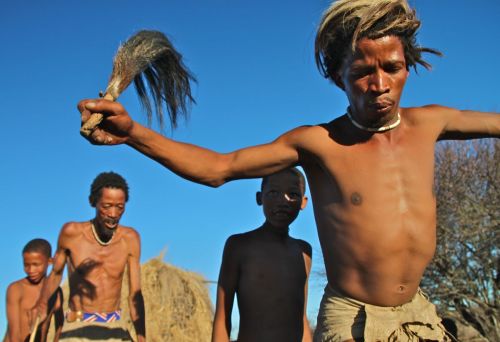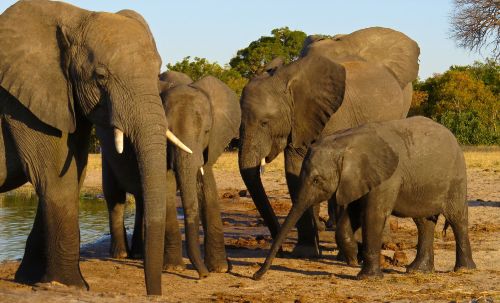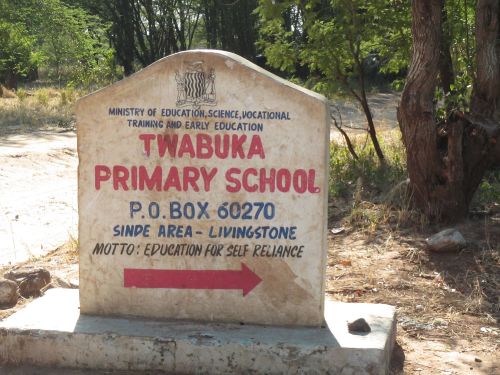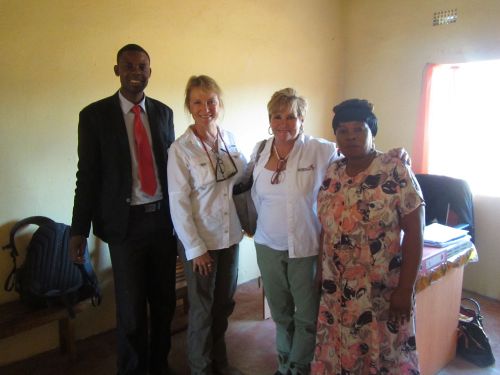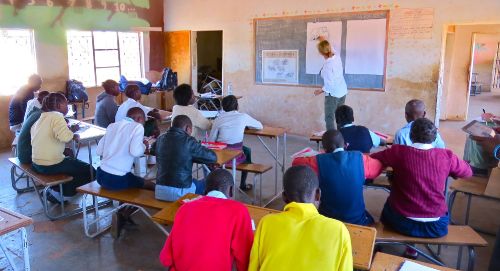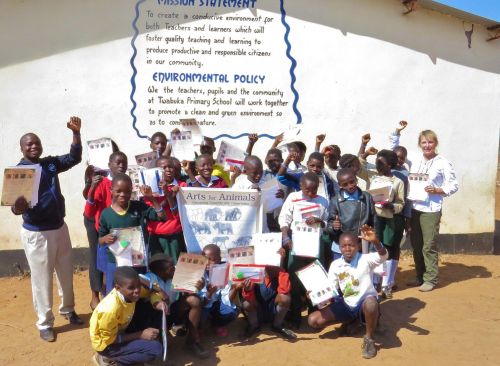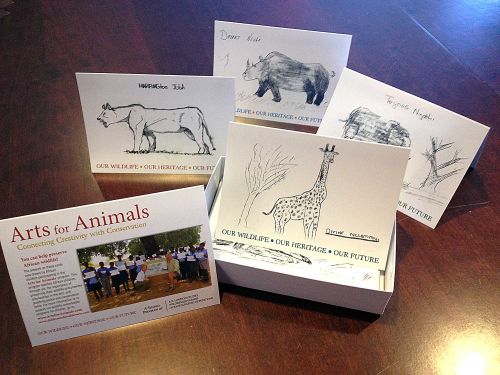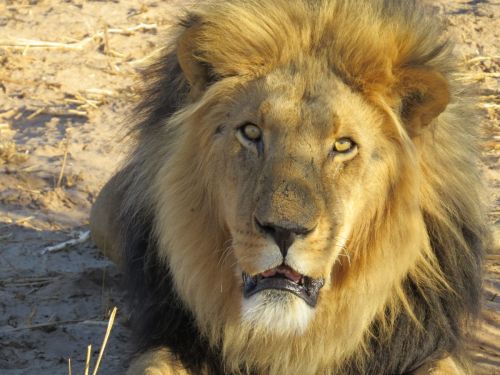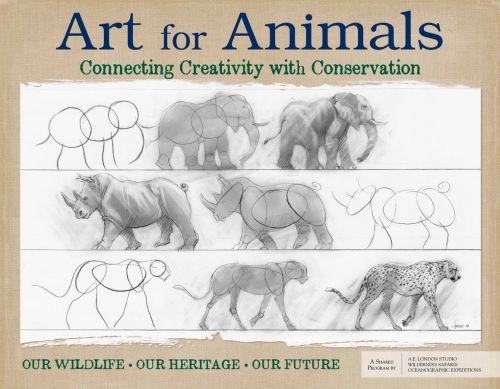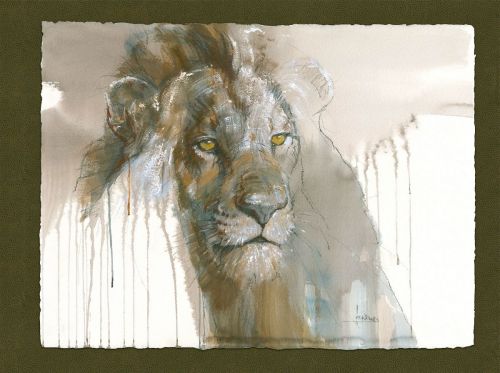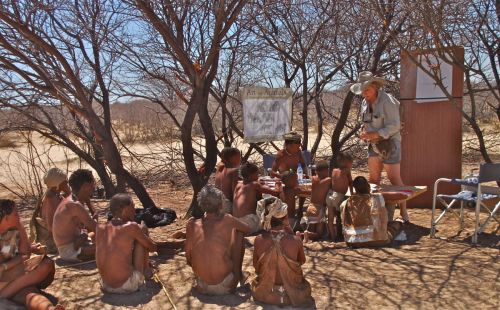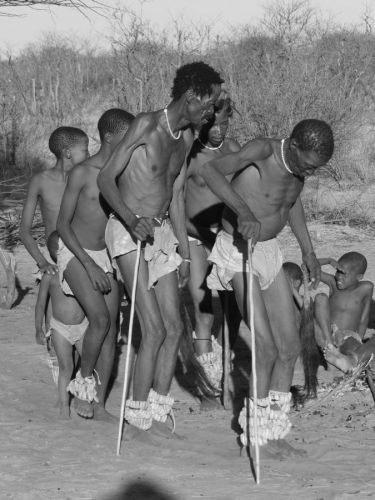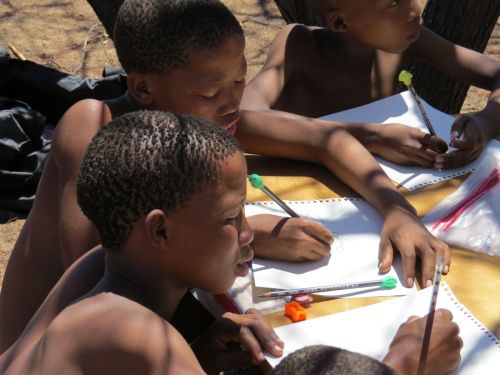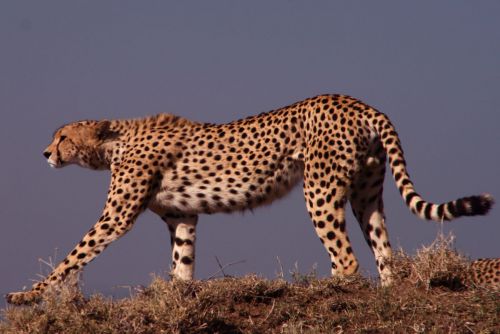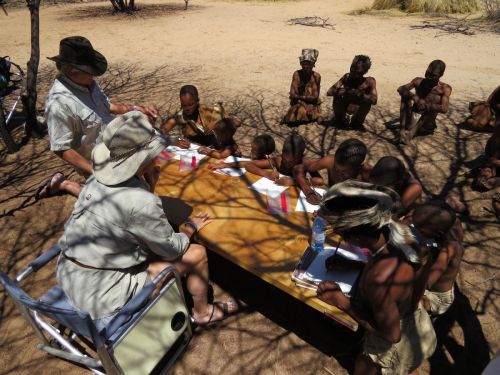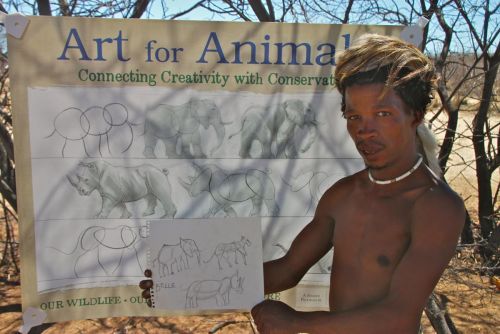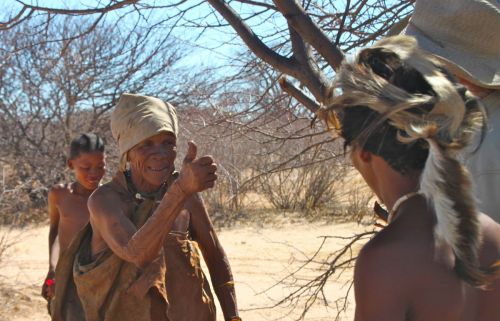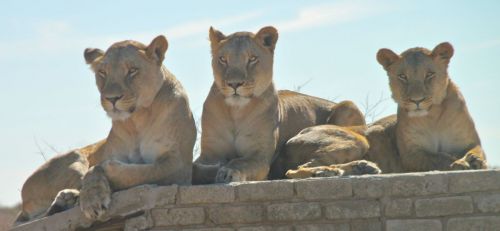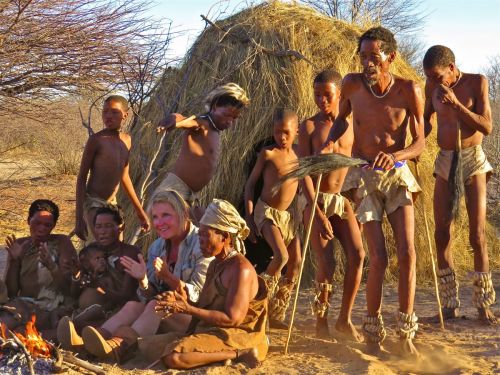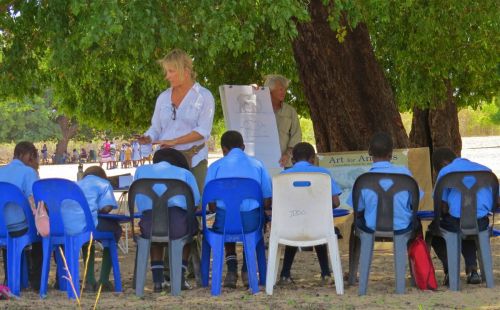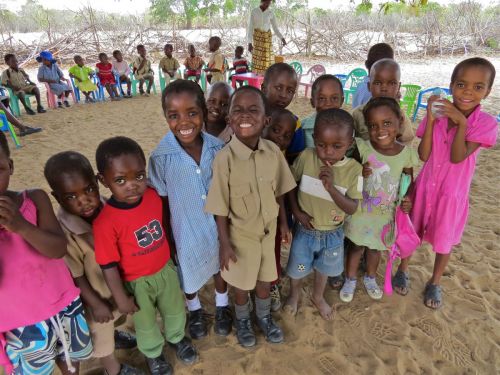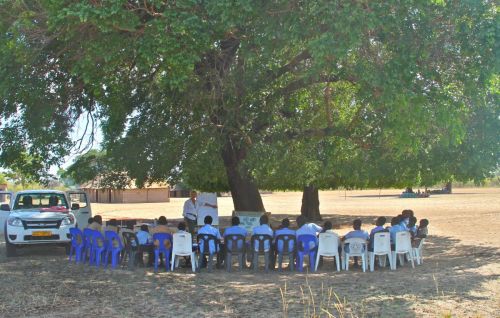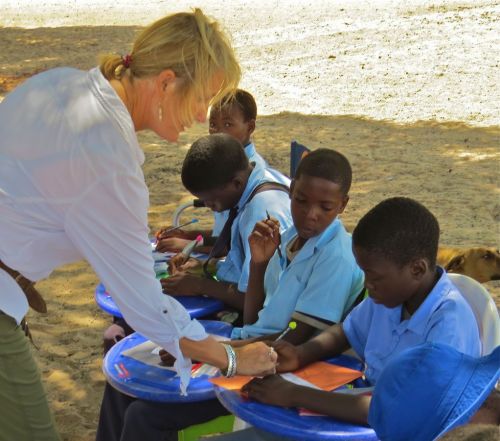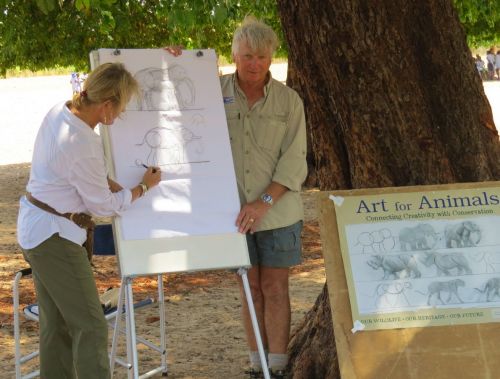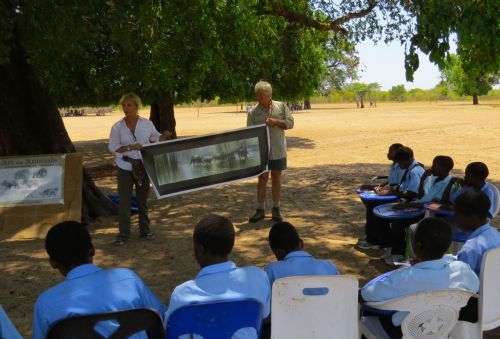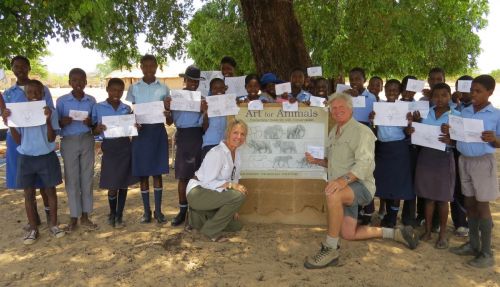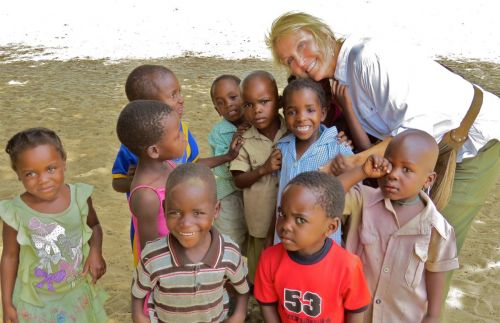This "Journal" is a record of the birth and history of ARTS FOR ANIMALS. It flows from the successes of today into the past and back to our humble beginnings. As you scroll through the entries and time advances, you can easily see our phenomenal growth and chart a growing number of children coming to understand the value of their wildlife.
Our path to starting Arts for Animals began many years ago, when Jim and I felt our first connections to wild animals. For me, it was the lions and elephants at Shambala Animal Sanctuary in California. For Jim, it was the aquatic wildlife surrounding him growing up in Louisiana. As the decades passed and those connections strengthened, it became apparent to both of us that preserving wildlife was in the marrow of our bones.
Throughout our lives, both Jim and I studied the science of the animals we loved, worked closely with conservationists, and developed lives that are focused on the preservation of endangered wildlife -- both on land and in the oceans.
When we each first visited Africa, we discovered the majesty and beauty of Africa's wildlife -- and the sad truth that many creatures may be doomed to extinction. A great philosopher once said, "All it takes for evil to triumph is for good men to do nothing."
Arts for Animals was born out of our personal desire to "do something" -- to make a difference, however small, in the future of African wildlife. We hoped to impact a few hundred children and enlist them in the fight to save the wonderful wildlife in their own backyards. We realized it is only with their help that animals like elephants, rhinos, cheetahs and painted dogs will remain on this Earth.
"Safari" is the Swahili word for "journey," and so this journal chronicles the safari of Arts for Animals from its inception to its accomplishments today.
Jim and I began in 2011, just as two earthlings who were willing to try to make a difference by using art to teach conservation to the children we met on our travels. Before long, we realized many others shared our concerns and also wanted to personally take some action to protect the future of our planet. To encourage and help those folks make a difference, we created this nonprofit, Arts for Animals, Inc.
In 2012, we taught our first "formal" group of African children and helped them tie their creativity to conservation. It has been a journey filled with encouragement, the enthusiasm of children, and renewed hope for animals facing extinction.
As one of our supporters said, "Each spark of creativity ignited adds to the collective light of the world."
We have been fortunate enough to have friends, supporters, and wildlife lovers who have supported us on this journey and, without whom, few of these goals would've been accomplished. Far, far fewer children would be understanding the value of their wildlife and recognizing what art and creativity can bring into their lives. With their help and yours, we are changing lives and the future of wildlife on our planet -- one child at a time.
As the years progressed, ARTS FOR ANIMALS has grown and prospered far more than we would have predicted. Each year brings us closer to our goal of protecting our planet's endangered wildlife for future generations. Today, after 15 years of effort and with the help of our partners around the planet, thousands of children each year are exposed to art and creative thinking and are being taught the value of protecting their wildlife.
We hope this "safari" will end only when animal poaching ends, with all wildlife prospering in their native habitats, and with the ongoing resurgence of artistic expression and creativity in Africa. With this journal, you can explore our lifelong Safari and we invite you along with us.........
Each year humpbacks come to the clear waters of Tonga to birth
Herman Melville once wrote," in no living thing are the lines of beauty more exquisitely defined than in the Crescentic borders of their flukes". there really is nothing like swimming with these Leviathans!
Our class in Tonga
These children will go back to their classrooms with a better appreciation of the value their wildlife represents and how important it is to protect their environment.
Four students ,A staff member of the Vava'U environmental protection Association and one volunteer picked for the whale experience.
These children might live their whole lives without understanding the importance of whales to their future as well as their heritage. This whale swim will give them valuable insights into the habitat itself.
Sunrise overlooking the waters of Tonga
There really is nothing like waking up and seeing whales spouting a couple of hundred yards into the ocean from where you stand.
Swimming with whales is an incredibly unique experience
While there,Anne and Jim , after noticing that the dive boats and whale boats were throwing their garbage into the water, made presentations to local operators stressing the importance of," taking only photographs and leaving only bubbles".
Our intrepid Tongan guide
After our discussions, it looks like the operators will start carrying garbage receptacles and bringing back items that used to be thrown in the water. We felt good about that!
The waters of Tonga are famous for their cetaceans and dolphins
Just like African wildlife, the wildlife on Tonga represents A critically important resource and a real future to the children of Tonga.
The art center is decorated with inspirational messages and artworks from artists from all over the United States.
The Zimbabwe government has assigned a permanent art teacher to the center and is using our art center as a model for new Wildlife centers at other Zimbabwean schools.
Working with other other Conservation programs like this one in Hwange,Zimbabwe
We are joining with the Center for Conservation to use the creativity and Conservation activities we developed to reach more children.
Our new "Partner"- The painted Dog conservation center Program near Hwange Park
This center teaches over 800 children each year about wildlife and wildlife conservation during the 4 days camps local children attend.
Helping to Teach Creativity to African kids at the Conservation Center Bush Camp
Drawing endangered species is a fine way to introduce African children to the importance their wildlife plays to their heritage and their future. On our recent visit to the conservation Center, we introduced Bush Camp kids to creativity and conservation
Creating their own wildlife conservation poster
These kids had a great time drawing wild dogs into their individual conservation posters. They will carry these posters back to their village and, hopefully, pass on conservation messages to their family and friends.
Our first class at the conservation Center
While in Victoria Falls, setting up the new art center building we began planning stages on the next phase.
The wildlife art centered next phase will include a large covered concrete area with picnic tables that the children can use for drawing and crafts when the center is not open .
The kids themselves helped us decorate the new arts center with their art.
The day after we decorated and opened the arts Center.
Classes in drawing began immediately. Surrounded by art from several American artists and Anne London, the kids are inspired to think creatively, and act responsibly toward their wildlife.
Our friend,Lori O'Neal help make this center possible.
Lori's Legacy is to change the lives of African children and help save their wildlife from extinction.
Inspirational messages in their own artwork create an atmosphere of creativity at the wildlife Center.
The Arts for Animals Wildlife Center will influence thousands of African children over the next decade
Without action elephants may be extinct by the end of this century
The future of African wildlife is in the hands of these children
Even Lions may be extinct by the end of the century as well
Connecting African children with the world's knowledge
This year we brought donated laptop computers which had been cleaned and prepped for use by African schoolchildren. Using these computers ,we can connect these children with artistic mentors or classrooms in the United States
Encouraging creativity and conservation in Zimbabwe
We focused on 2 schools near Hwange national Park. By helping the children draw animal murals on the walls and developing their drawing skills on paper, they learned about art and the importance of their wildlife to their future.
Drawing awakens the creativity of these children
Once the children's interest is aroused, they become more receptive to the idea that not only must they coexist with the wildlife in the park nearby - they must protect it.
After their art lesson, they take an oath to protect animals.
These 25 children from 2 schools near Hwange Park, make a pledge to protect their wildlife from poachers and harm. Afterward, they receive a written contract that they sign showing how important wildlife and the environment is to their future.
Presenting the 1st computers to local Zimbabwean teachers
Showing off their new " animal protector" wristbands!
Creating an army of thousands of Africans who love,appreciate and protect their wildlife- 25 kids at a time!
Seeing the importance of the "Animal Protectors" firsthand
On the way back to our camp, we passed through Hwange National Park and saw dozens of elephants. Without the local people protecting these magnificent creatures, slowly but surely ,they will disappear
There is nothing more priceless than the experience of watching an elephant family living in peace
It is estimated that almost a dozen elephants are killed each and every day by hunters, poachers, and illegal snares. If we can get hundreds or thousands of local children understanding the importance of these animals- they can be protected.
One of the rural schools we visit in Zambia
Anne meeting with local school represenatives
Anne, and Sue Goatley the "Children in the Wilderness" represenative meet with the principle and the local education minister to discuss teaching wildlife conservation and art.
Again ,the children really respond to art and Anne's messages
Outside the school showing off their wristbands
Environment and wildlife conservation are both stressed at this school. The Zambian schools have more resources than Zimbabwean schools but the Zambian children need motivation to save their wildlife just as much.
This school has the potential to turn out tomorrows leaders
Many of the leders in Africa come from rural schools like this one. If we can teach them the value of wildlife when young ,they can grow up to change the course of African history.
Our 1st poster
The goal was simple- to introduce art into the lives of African children and direct their enthusiasm and creativity to teach the importance of wildlife to their future.
We wanted to inspire these African children.
We printed several pieces of artwork on vinyl banner material so that the children could have lasting examples of what was possible.
Our 1st class - teaching young bushman about art and conservation.
With our poster wired between 2 Mopani trees (the only shade in the Kalahari desert), and using an old door to draw on, we spoke to the bush kids and thir parents about wildlife.
The bushman still lead very primitive lives.
This is the oldest culture on the planet. Scientists have just found evidence in caves in South Africa of bushman art from 30,000 years ago!
Bushman children expressing themselves creatively for the 1st time in their lives.
Sitting on the ground, and using another old door as a desk, these children get their 1st lesson in drawing and conservation stewardship.
Cheetahs, for example, are no longer seen in this area
As the children learn to draw elephants, rhinos, and cheetahs, we talked about the importance of these animals to their heritage as well as their future. Few of these children realize that cheaters are now found only in their homeland and nowhere else.
The adults looked on with interest
As she spoke to the children about the importance of their wildlife, the adults nodded positively and we could tell they appreciated the importance of their wildlife.
We spoke through an interpreter and used our poster to teach
Even our interpreter BELL E, tried his hand at drawing. The whole group was enthusiastic about learning to draw and the importance we placed on their wildlife.
A sense of accomplishment
A thumbs-up from this old Bush woman told us that we were on track. She felt it was an important lesson and missed the days when she saw elephants, rhinos and wildlife around her.
The apex predator project
These bushmen lived in a sanctuary where problem lions had been brought to condition them to no longer eat cattle. They are fed wild game and Cattle meat that is been treated to make them ill.
Our friends get to learn about this ancient culture.
The Lions kept here can be released back into the wild will no longer attack cattle. By supporting this project, we help wildlife and learn about the magic of the bushman.
Later we moved on to Jubalani school in Zimbabwe
Jubalani School was founded several years ago by a woman who wanted local kids to get an education. She started with 3 children and a small tent.
Jubalani means "Happiness" !
Today, she teaches over 450 children and with the help of Children in the Wilderness( a division of wilderness safaris) these children not only get an education but also a nutritious lunch. For many, it is their only real meal of the day.
Their classrooms take place under trees in the schoolyard.
The 1st year, we taught 30 students how to draw endangered species and the importance of those species to their heritage and their future.
For most, this was the 1st art lesson in their lives.
We had the children's rapt attention and interest
Mixing facts about African wildlife with drawing techniques enabled us to engage the children in wildlife stewardship discussions.
After our lessons, we showed them examples of what they could do someday.
We printed some of Anne's artworks on vinyl banner material so that it could be used in their mud classrooms without being harmed by weather or insects
The children's artwork was wonderful!
For beginners, the children's artwork was quite good and their excitement and interest was infectious.
The children's smiles were our biggest reward.
After our lessons, many of the children came up to us and expressed how much our time with them meant to them.
